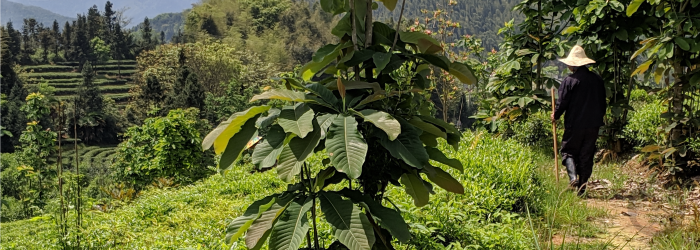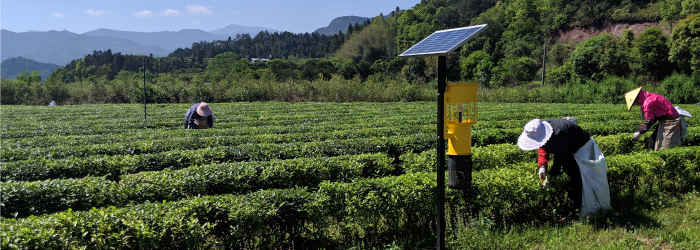What Makes Tea Sustainable?

There are many aspects of the mass-market supply chain that fall short of sustainable, yet these widely-available brands are often among the most vocal in their marketing efforts. Meanwhile, older traditions of natural farming, skilled crafting, and minimal packaging go largely unsung in the conversation about sustainability.
Find out why we always source teas from small farms >>
So what exactly makes a tea sustainable? Growing methods that avoid chemical fertilizers, pesticides, and herbicides help to preserve the health of the soil and terroir where teas are produced. Fair wages paid to harvesters and crafters ensure that vulnerable populations are not exploited for cheap labor. And minimal packaging helps reduce waste, both in production and consumption.
Happily, these conditions correspond with the requirements for high quality flavor: that tea leaves are grown slowly, crafted carefully, and kept whole. Small producers often achieve sustainable practices simply by focusing on quality over quantity.
Find out more about our standards for high quality tea >>
Natural Growing Methods
For large companies that need to produce big, consistent harvests, low-elevation farms treated with fertilizers, pesticides, or herbicides hold many advantages. Lower elevations mean warmer temperatures and more available groundwater. In some climates, tea can grow all year round, and chemical fertilizers can increase crop yields even more. Pesticides remove the threat of lost crops, while herbicides kill off weeds to reserve all nutrients in the soil for tea plants.
Learn more about seasonal growth and flavor development in this video:
But the resulting flavor suffers. Fast growth, and especially year-round harvests, don’t allow the plant enough time to form complex flavor compounds. Despite the effect of pesticides, plants produce more bitter compounds to protect against plentiful insect populations in warm weather. The monoculture created by herbicides reduces the diversity of nutrients available in the soil, which also reduces flavor complexity.
Learn what signs of sustainability we look for when visiting tea farms >>
Many mass-market tea companies offset flat or bitter flavors by blending teas with herbs, flowers, or spices. Still, these blends fall short of the depth of flavor in pure tea, which can linger in the throat long after the tea is swallowed and reveal layer after layer through multiple infusions.
These are the flavor qualities small producers are after, and traditional farmers use a combination of time-tested growing techniques and modern technologies like cover crops, solar-powered pest traps, and innovative crafting methods to maximize crop yields without sacrificing the finished product. In addition, highly regarded, family-owned farms, passed down from generation to generation, have a vested interest in preserving the quality of the terroir that makes their teas worth so much. With leases on farmland granted by the Chinese government for periods of either 99 or 999 years, every piece of land is a legacy.
Learn more about sustainable approaches to pest control >>
Labor at a Living Wage
The second essential aspect of sustainable tea is labor. Just as care must be taken to preserve the environmental terroir in order to keep producing high quality tea, the talents of harvesters and crafters must be recognized for the value they add to the finished product. Ever since the dissemination of tea as a drink for the masses, the time-intensive steps of harvesting and crafting have been targets of cost cutting measures by large scale producers.
Explore the six steps of tea processing >>
When the British established the first plantations in India, this was achieved through indentured servitude of native populations, a practice which unfortunately continues today in some areas. In more recent times, many mass market tea companies have turned to machines to harvest teas, but fueling these machines with fossil fuels carries new consequences for the environment, while also sacrificing quality by chopping or breaking leaves into small pieces.
For the best flavor quality, tea leaves must be kept whole, which can only be achieved by careful hand plucking. In addition, most tea styles are made from a particular plucking standard, meaning harvesters need to be skilled in selecting the correct combination of leaves and buds from every stem. This is the primary reason that harvesting machines have never been able to meet the same standards of quality, since they only shear an indiscriminate layer from the top of each tea bush.
In China and Taiwan, where there is a large market for high quality, whole leaf teas, farmers with a limited amount of land will pay well for harvesters and crafters that can maximize the value of every leaf. Increasing economic growth, however, has led to labor shortages for the seasonal workers required in rural areas, as young people move to the cities for less difficult jobs in retail or hospitality. Today, farmers must compete with high wages to attract the skilled tea workers that can produce high quality tea.
Learn more about labor practices in the Chinese tea industry >>
Of course, in order for these farms to continue producing year after year, they must also sell their tea for higher prices to maintain the level of quality they are known for. As buyers, we must also compete with an increasingly rich domestic consumer base that is willing to pay what production costs demand. To sustain the high quality and traditional crafting of the teas we love, we must also be prepared to pay sustainable prices.
Learn more about our sourcing process in this video:
Minimal Packaging
Finally, on the consumer’s end of the supply chain, the most visible aspect of sustainability is the packaging that teas come in. The environmental impact of materials used in tea bags has come under much scrutiny in recent years, but this is only one reason of many that we prefer loose leaves over teas that come in bags.
Read more about how bagged teas compare to loose leaves >>
Bagged teas, especially those commonly available on grocery store shelves, typically contain lower quality leaves, for all the reasons discussed above. Whether or not these large companies have made the effort to produce eco-friendly packaging, the teas contained inside are rarely as flavorful or interesting as a natural, single-origin tea. Instead, companies that tout eco-friendly packaging invest their capital into this selling point, while continuing to source large quantities of low-quality leaves.
Ironically, the high end bagged teas that often contain better quality leaves are usually the ones with the most negative environmental impact. ‘Silken’ bags sewn in pyramid shapes to allow for expansion of whole leaves are typically made of synthetic nylon, while the same leaves in loose form would be fully biodegradable and equally easy to brew in a reusable infuser basket.
Watch Alice compare loose and bagged teas in this side-by side brewing demo:
Even when all parts of the packaging are eco-friendly, there is an environmental and monetary cost to producing them. To us, the extra cost of tea bag packaging is better spent on the quality of the tea leaves themselves. Whole leaves stored in reusable tins remain fresh and flavorful longer than broken leaves in individual foil wrappers, anyway.
Learn how to store tea for maximum freshness >>
What do you look for in a sustainable tea? Let us know in the comments below!
Sign up for our newsletter to get blog updates in your inbox!







Comments on this post (2)
Hello Joan,
The best temperature for tea can vary depending on the level of oxidation, with lighter leaves often brewing better at a lower temperature.
However, once water reaches the point of boiling, it begins to evaporate into steam rather than continuing to rise in temperature. Therefore, there is little to no temperature difference between water that has just reached a boil and water that reaches a rollicking boil.
— Amy
Shouldn’t the tea water be brought just to a boiling point rather than to a rollicking boil or beyond?
— Joan Brownell